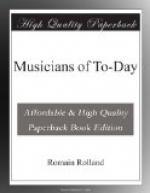From a purely musical point of view there is some resemblance between M. Saint-Saens and Mendelssohn. In both of them we find the same intellectual restraint, the same balance preserved among the heterogeneous elements of their work. These elements are not common to both of them, because the time, the country, and the surroundings in which they lived are not the same; and there is also a great difference in their characters. Mendelssohn is more ingenuous and religious; M. Saint-Saens is more of a dilettante and more sensuous. They are not so much kindred spirits by their science as good company by a common purity of taste, a sense of rhythm, and a genius for method, which gave all they wrote a neo-classic character.
As for the things that directly influenced M. Saint-Saens, they are so numerous that it would be difficult and rather bold of me to pretend to be able to pick them out. His remarkable capacity for assimilation has often moved him to write in the style of Wagner or Berlioz, of Haendel or Rameau, of Lulli or Charpentier, or even of some English harpsichord or clavichord player of the sixteenth century, like William Byrd—whose airs are introduced quite naturally in the music of Henry VIII; but we must remember that these are deliberate imitations, the amusements of a virtuoso, about which M. Saint-Saens never deceives himself. His memory serves him as he pleases, but he is never troubled by it.
As far as one can judge, M. Saint-Saens’ musical ideas are infused with the spirit of the great classics belonging to the end of the eighteenth century—far more, whatever people may say, with the spirit of Beethoven, Haydn, and Mozart, than with the spirit of Bach. Schumann’s seductiveness also left its mark upon him, and he has felt the influence of Gounod, Bizet, and Wagner. But a stronger influence was that of Berlioz, his friend and master,[130] and, above all, that of Liszt. We must stop at this last name.
[Footnote 130: “Thanks to Berlioz, all my generation has been shaped, and well shaped” (Portraits et Souvenirs).]
M. Saint-Saens has good reason for liking Liszt, for Liszt was also a lover of freedom, and had shaken off traditions and pedantry, and scorned German routine; and he liked him, too, because his music was a reaction from the stiff school of Brahms.[131] He was enthusiastic about Liszt’s work, and was one of the earliest and most ardent champions of that new music of which Liszt was the leading spirit—of that “programme” music which Wagner’s triumph seemed to have nipped in the bud, but which has suddenly and gloriously burst into life again in the works of Richard Strauss. “Liszt is one of the great composers of our time,” wrote M. Saint-Saens; “he has dared more than either Weber, or Mendelssohn, or Schubert, or Schumann. He has created the symphonic poem. He is the deliverer of instrumental music.... He has proclaimed the reign of free music."[132] This was not said impulsively in a moment of enthusiasm; M. Saint-Saens has always held this opinion. All his life he has remained faithful to his admiration of Liszt—since 1858, when he dedicated a Veni Creator to “the Abbe Liszt,” until 1886, when, a few months after Liszt’s death, he dedicated his masterpiece, the Symphonic avec orgue, “To the memory of Franz Liszt."[133]




